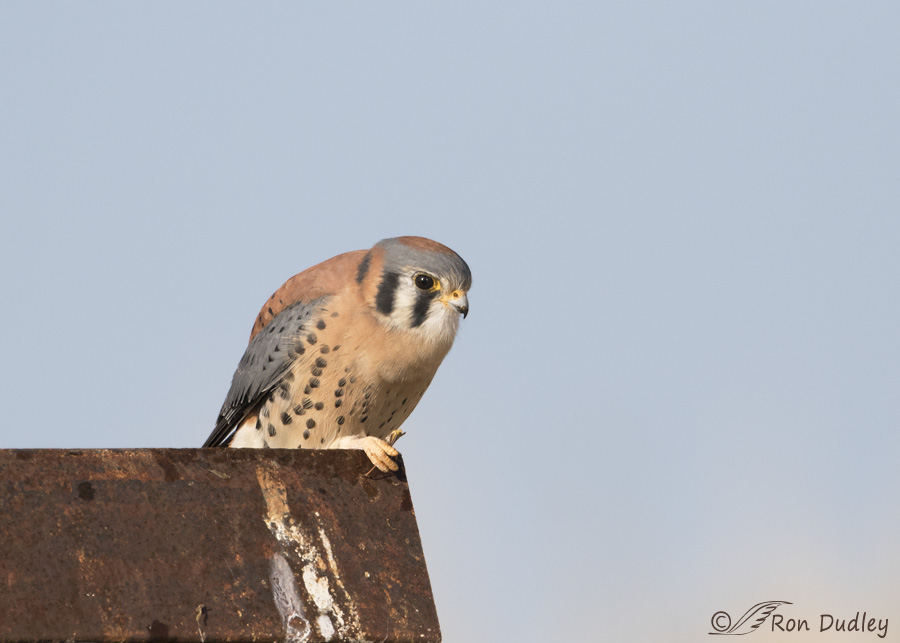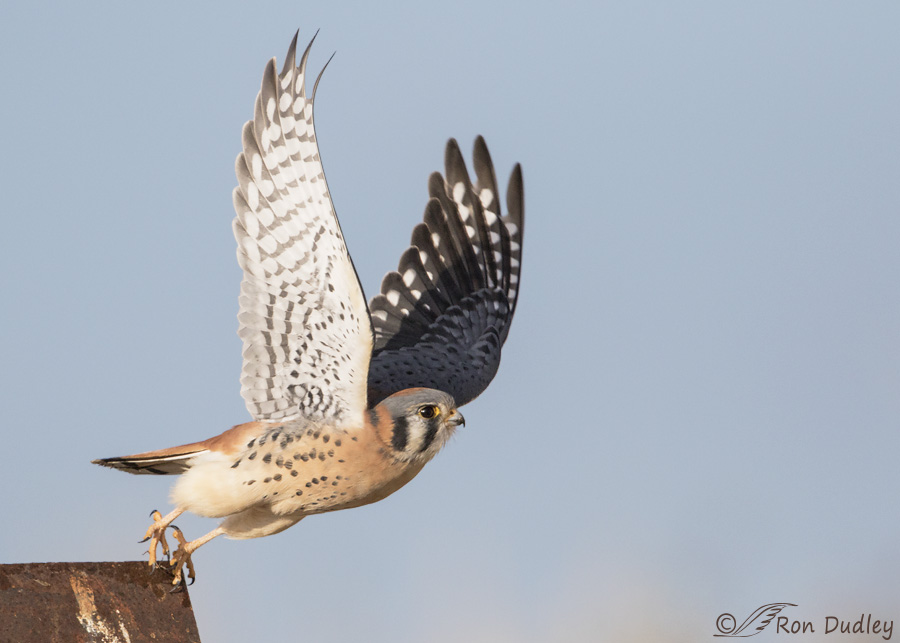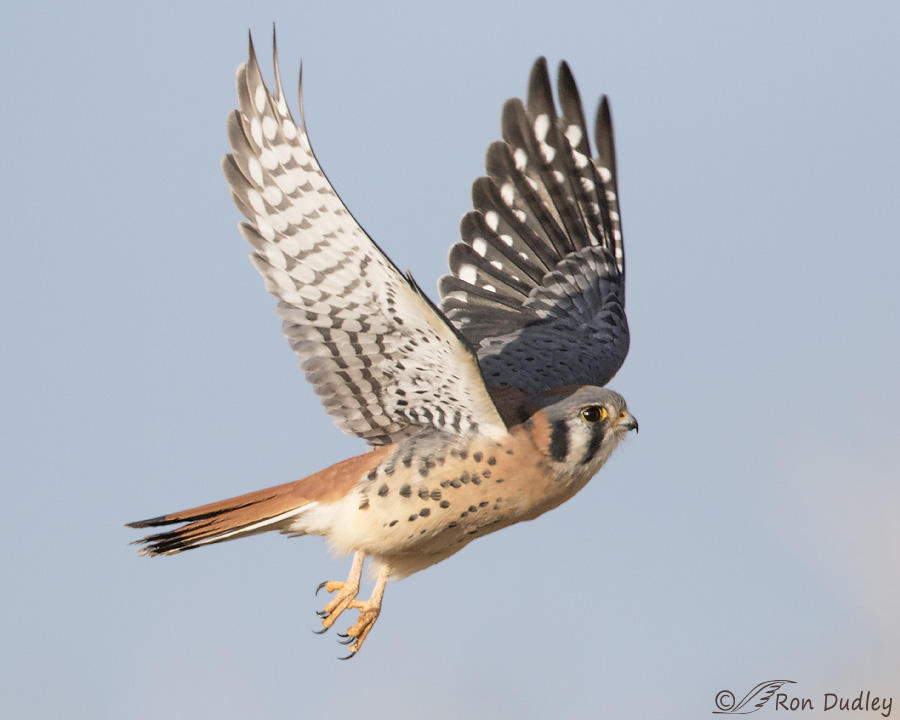Because of their small size and quickness kestrels are the most challenging raptor I attempt to photograph at takeoff. Typically I clip or cut off body parts or get nothing but “air shots”. But yesterday morning at Farmington Bay WMA I had better luck.
 1/3200, f/6.3, ISO 640, Canon 7D Mark II, Canon EF 500mm f/4L IS II USM + EF 1.4 III Extender, not baited, set up or called in
1/3200, f/6.3, ISO 640, Canon 7D Mark II, Canon EF 500mm f/4L IS II USM + EF 1.4 III Extender, not baited, set up or called in
I found this beautiful male enjoying a snack (what was left of a large insect – perhaps a grasshopper) atop a rusty old gravel separator at the refuge. When he finished his meal I hoped he would take off to my right and my reflexes would be fast enough to get the entire bird in frame, although I didn’t have high hopes of success because I’d failed so many times before.
These are tense situations for me. I often feel like I’m a coiled spring with my finger depressing the shutter button like a hair trigger and waiting, often for a very long time, for the bird to take off. And when it eventually does my reflexes are usually too slow or the bird takes off in the wrong direction. Or both.
 1/5000, f/6.3, ISO 640, Canon 7D Mark II, Canon EF 500mm f/4L IS II USM + EF 1.4 III Extender, not baited, set up or called in
1/5000, f/6.3, ISO 640, Canon 7D Mark II, Canon EF 500mm f/4L IS II USM + EF 1.4 III Extender, not baited, set up or called in
But this time things worked out. The kestrel launched in about the best direction possible, the light is pretty good, I like the wing position and the stretched-out feet, there’s light in the eye and the bird is sharp.
- Photographers might note that since I shoot in aperture priority my shutter speed jumped dramatically as soon as the bird raised its right wing and presented that mostly white and bright underside.
 1/5000, f/6.3, ISO 640, Canon 7D Mark II, Canon EF 500mm f/4L IS II USM + EF 1.4 III Extender, not baited, set up or called in
1/5000, f/6.3, ISO 640, Canon 7D Mark II, Canon EF 500mm f/4L IS II USM + EF 1.4 III Extender, not baited, set up or called in
And the 10 frames/second burst rate of my 7D Mark II even gave me a full flight shot before the kestrel was out of frame. This image isn’t quite as sharp as the previous one and I don’t like the way the back of his head is shaded by the wing but I was still very happy to get the shot.
I’m seeing a few more kestrels at Farmington lately and migrating Northern Harriers are beginning to come in to augment our small resident population. I was also encouraged to see my first Bald Eagle of the season at the refuge several days ago (a 4th year bird).
Things are finally beginning to look up at Farmington!
Ron


Stellar shot of a tough raptor…excellent all the way around Ron!
stunningly beautiful. I love the picture of the ‘jumping off’
Thank you, Gillycat.
Stunning. I love that launch into free fall. Which zooms into powered flight.
Yesterday I captured half a bird flying along our veranda. And thought of you.
My ever loving family told me among other things) that I am as stubborn as stains. Which is not always a negative.
Half birds are my specialty, EC. Better than half-assed I guess but not by much…
I have no pride. And very little shame. I posted my half bird.
Ha, I found it. And it was the rear half to boot. When you do a half bird you do it well!
http://myjustsostory.blogspot.com/2016/11/sunday-selections-301.html
Aren’t they just beautiful raptors? Terrific photographs, Ron! Thank you, Frank, for the “wordy” comments and questions. Helps me refine my thought process for approaching similar situations.
More teaching, more learning, more fun.
I’m glad you found the photo-geekiness of those two comments helpful, Wally.
Love these shots Ron, lived in SL for ten years, but didn’t have my 10D back then.. ah.. oh well. Will be fun to follow you. Nice work.
Welcome aboard, Ron. And thanks.
What gorgeous photos! I’m glad you are seeing more Kestrels – they are very special birds. Don’t worry about the shadow on this guy’s head – when I look at it I see a Jewish bird wearing a yarmulke…
“when I look at it I see a Jewish bird wearing a yarmulke”
That’s what I’ll probably see from now on, Susan!
OMG, Ron!! These photos are unbelievably stunning!! Some wildlife are not what you would call beautiful but this little Kestral is certainly spectacular. So glad your patience paid off!! I have to agree with Dick about the patience of a sniper!! I’m a huge NCIS fan and a recent story was about a wounded sniper with PTSD!! The Soldier and Gibbs were talking about what it’s like to be a Sniper and Dick’s comments brought it back to me. Besides the patience they also included another quality to being a sniper which I also think applies to Nature photographers – and appears to me to fit you too – stubbornness!! So glad you have those qualities – because you are rewarded with quality captures we all enjoy!!
Guilty as charged about being stubborn, Jo Ann.
Hi Ron, another great success story. I get it about loosing the bird in the frame or clipping, but you got this series and there are really good. The third is a little soft comparatively but still great. I am curious, had the bird flown out of your AF points (were they active at the moment of exposure), hence you were starting to loose focus, or had you set your focus and hoped for the best. I ask because yesterday I was shooting small birds in rabbit brush and had a similar opportunity. The focus on the bird while perching was right on. I was using 5 center placed focus points, AI Servo, surround I think is what Canon calls it. The bird launched to my right and I caught him at 1/3200 in the right part of the frame, but once cropped, there was plenty of room in front of him to keep the perspective I prefer. But he was a little soft (recoverable in PP but still I would have liked him a little sharper). In other words, your example today shows exactly what I experienced yesterday. So I am thinking of experimenting. Instead of keeping BBF active at the moment of exposure, I wonder whether I should try acquiring focus initially and, anticipating the bird will launch, don’t refocus and hope for the best. A little wordy here and I apologize, but would appreciate your thoughts.
Again, great word and it sounds like you have some good opportunities coming up at Farmington.
Frank
Very good question, Frank.
The method you’re thinking about trying is exactly the one I used here. My AF point wasn’t active when the bird took off.
In situations like this I want sharp focus on the face of the bird while it’s perched. But if I keep the point active during takeoff I typically lose focus on the bird as it leaves my active focus points. So in these situations I usually take my finger off the back button and hope the bird flies right or left and stays in the same plane as when it was perched so it’s still sharp during takeoff and immediately after.
The reason the kestrel in that last shot is a little soft is because it didn’t stay in exactly the same plane after launch but if I’d had my AF point active on the perched bird that shot would have been nothing but a blurry blob.
True, I’m screwed if the bird takes off toward me but in these situations that’s a chance I’m often willing to take.
I don’t mind the wordy, these are questions I am playing with myself. Thank you for asking Frank and answering Ron.
Love these. And I do agree that the shadow of the wing mars the shot a bit (when I look at it with a Dudley-trained eye) but still…what a beauty.
Shadows like that one can be a pain in the butt, Arwen. There’s just soooo many things that can go wrong…
Outstanding shots! I often feel that catching a great takeoff or flying shot of a Kestrel, is only a dream, but you give me hope!
Go for it, Everet. Occasionally dreams do come true, especially if you work at it.
PERFECTION!!! Dick is so right! I like the way the rusty sign echoes the sienna of the bird…you’ve got to be super pleased with these wonderful images….yes?
Thanks, Patty. Yes, I’m quite pleased with the last two shots.
Beautiful! You “got it”! The “hurry up and wait” drives me nuts at time!
The “hurry up and wait” drives me nuts at time! 
“hurry up and wait” drives me nuts at times”
Yup, that’s it, Judy!
But what REALLY drives me nuts is when the bird chooses the split-second I look away (to check my settings or scratch my nose) to take off. I’ve been known to cuss birds at times like that…
Agreed!
LOL scratch my nose, boy have I been there!
ÀWSOME SHOTS Ron! I bet this is the secret desire of every bird photographer and you Nailed it!! Congrats!!
Charlotte
All I can say is that it’s MY desire and it isn’t all that secret either! Thanks, Charlotte.
Well done Ron. I’d be thrilled with any of those images.
Thanks very much, Rob.
What a beautiful raptor! Your skill and patience are definitely being rewarded these days. I love seeing the “polka dots” on the wing feathers. These kinds of markings always make me wonder about and marvel at the mechanism of gene expression.
“make me wonder about and marvel at the mechanism of gene expression”
Ahh, a man after my own heart, Marty. My thoughts OFTEN go there too!
Ahhhh, ooooh – beautiful shots, you did good!!
A nature photographer needs to have the patience and coolness of a military sniper. Regardless of what you say, I believe you have those characteristics in spades!
You won’t get your quarry every time, but from our standpoint you do get some mighty fine pictures!
“A nature photographer needs to have the patience and coolness of a military sniper”
I’ve never heard it put that way but in many situations you’re exactly right, Dick.